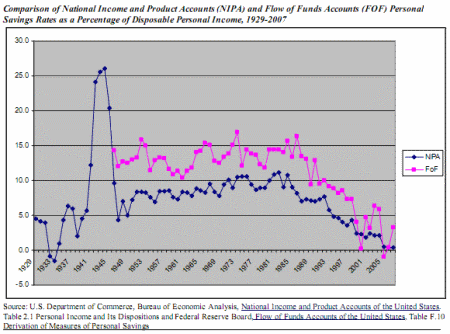
(1) The negative view is what you get a regular dose of in this blog and I needn't belabor it much. Here, the US is a once-great nation whose exporting industries have entered terminal decline. That is, its production of tradable goods has given way to a consumption-led Anglo-Saxon model that exacerbates its lack of savings, making the US reliant on the the kindness of strangers to fund its profligacy. Like Rocky-era Survivor, it's changed its passion for glory and lost its grip on the dreams of the past. The US has literally gone soft in the middle, further straining its also parlous public finances.
(2) OTOH, the positive view portrays the US in more flattering terms. Among the proponents of this view are authors championing the existence of a "Bretton Woods II" system. Here, postwar America acted generously by allowing war-torn Europe and Japan to export to the only consumer market left largely intact by WWII. Even the breakdown of the original Bretton Woods II system did not stop the US from acting as the world's consumer of last resort. In effect, newer export-led economies used fixed exchange rates and reserve accumulation to preserve America's status as such. Hence, the so-called Asian tigers (South Korea, Taiwan, Singapore, and Hong Kong) were able to follow Japan's lead and, after a lag, the PRC.
It is at the present time when (1) and (2) converge. With the benefit of hindsight, the US-as-intermediary story in (2) which portrayed the global economic order as "stable and sustainable" has been largely discredited by the credit crunch. The reason is simple: US consumers have simply run out of spending money as personal savings rates approached zero. Of course, there is a grain of truth to (2) in that US consumption has played an important role in the development of the aforementioned export-led economies. Even now, US consumption alone accounts for about 18% of world GDP by my reckoning, although others say it is more like 20%. You may think this isn't much in the global scheme of things, but consider the US as a "swing consumer" that can influence prices for America's all-important consumer credit via its monetary, exchange rate, and trade policies. As consumer of last resort, this role is key.
The chart speaks for itself. Bretton Woods II or whatever you call it has run aground simply due to American consumers hitting rock bottom. Export-led economies can no longer rely on the American consumer to pick up demand slack and must somehow stimulate domestic demand. Conversely, the US will need to address long-neglected industries in the tradable sector to escape the gravitational pull of its consumption-led growth model. Doing so is not an easy task for either as evidenced by US efforts to reflate consumption via virtually zero policy rates and exporters like China ladling on export incentives.
We are entering an interesting new phase for the postwar international economic order. It is often said that America's Anglo-Saxon model based on consumption and financial intermediation is endangered. Less often said is the obverse: Asia's export-led development model cannot which is in no small predicated on US consumption is similarly endangered. How we can move forward is the topic for another post, but the chart above should be plenty to digest for now.

